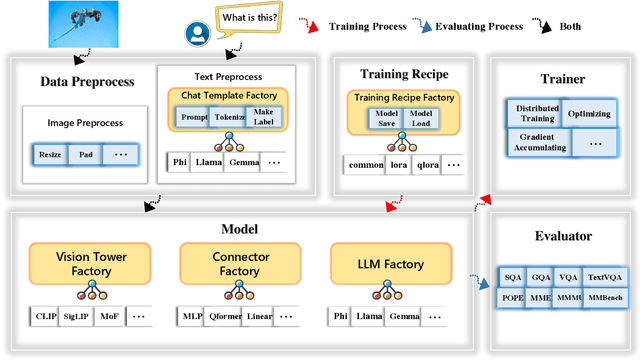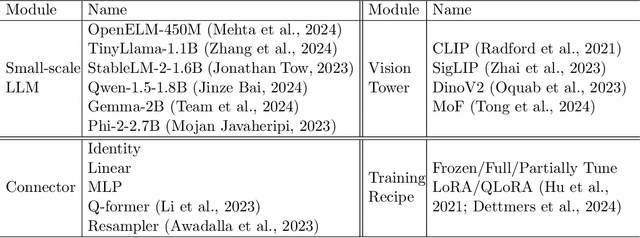Jie Luo
Coarse-to-Fine Semantic Communication Systems for Text Transmission
Apr 02, 2025Abstract:Achieving more powerful semantic representations and semantic understanding is one of the key problems in improving the performance of semantic communication systems. This work focuses on enhancing the semantic understanding of the text data to improve the effectiveness of semantic exchange. We propose a novel semantic communication system for text transmission, in which the semantic understanding is enhanced by coarse-to-fine processing. Especially, a dual attention mechanism is proposed to capture both the coarse and fine semantic information. Numerical experiments show the proposed system outperforms the benchmarks in terms of bilingual evaluation, sentence similarity, and robustness under various channel conditions.
1-Tb/s/λ Transmission over Record 10714-km AR-HCF
Apr 02, 2025Abstract:We present the first single-channel 1.001-Tb/s DP-36QAM-PCS recirculating transmission over 73 loops of 146.77-km ultra-low-loss & low-IMI DNANF-5 fiber, achieving a record transmission distance of 10,714.28 km.
Bridging Domain Gaps between Pretrained Multimodal Models and Recommendations
Feb 21, 2025Abstract:With the explosive growth of multimodal content online, pre-trained visual-language models have shown great potential for multimodal recommendation. However, while these models achieve decent performance when applied in a frozen manner, surprisingly, due to significant domain gaps (e.g., feature distribution discrepancy and task objective misalignment) between pre-training and personalized recommendation, adopting a joint training approach instead leads to performance worse than baseline. Existing approaches either rely on simple feature extraction or require computationally expensive full model fine-tuning, struggling to balance effectiveness and efficiency. To tackle these challenges, we propose \textbf{P}arameter-efficient \textbf{T}uning for \textbf{M}ultimodal \textbf{Rec}ommendation (\textbf{PTMRec}), a novel framework that bridges the domain gap between pre-trained models and recommendation systems through a knowledge-guided dual-stage parameter-efficient training strategy. This framework not only eliminates the need for costly additional pre-training but also flexibly accommodates various parameter-efficient tuning methods.
Clustering Properties of Self-Supervised Learning
Jan 30, 2025Abstract:Self-supervised learning (SSL) methods via joint embedding architectures have proven remarkably effective at capturing semantically rich representations with strong clustering properties, magically in the absence of label supervision. Despite this, few of them have explored leveraging these untapped properties to improve themselves. In this paper, we provide an evidence through various metrics that the encoder's output $encoding$ exhibits superior and more stable clustering properties compared to other components. Building on this insight, we propose a novel positive-feedback SSL method, termed Representation Soft Assignment (ReSA), which leverages the model's clustering properties to promote learning in a self-guided manner. Extensive experiments on standard SSL benchmarks reveal that models pretrained with ReSA outperform other state-of-the-art SSL methods by a significant margin. Finally, we analyze how ReSA facilitates better clustering properties, demonstrating that it effectively enhances clustering performance at both fine-grained and coarse-grained levels, shaping representations that are inherently more structured and semantically meaningful.
MMedAgent: Learning to Use Medical Tools with Multi-modal Agent
Jul 02, 2024



Abstract:Multi-Modal Large Language Models (MLLMs), despite being successful, exhibit limited generality and often fall short when compared to specialized models. Recently, LLM-based agents have been developed to address these challenges by selecting appropriate specialized models as tools based on user inputs. However, such advancements have not been extensively explored within the medical domain. To bridge this gap, this paper introduces the first agent explicitly designed for the medical field, named \textbf{M}ulti-modal \textbf{Med}ical \textbf{Agent} (MMedAgent). We curate an instruction-tuning dataset comprising six medical tools solving seven tasks, enabling the agent to choose the most suitable tools for a given task. Comprehensive experiments demonstrate that MMedAgent achieves superior performance across a variety of medical tasks compared to state-of-the-art open-source methods and even the closed-source model, GPT-4o. Furthermore, MMedAgent exhibits efficiency in updating and integrating new medical tools.
TinyLLaVA Factory: A Modularized Codebase for Small-scale Large Multimodal Models
May 20, 2024


Abstract:We present TinyLLaVA Factory, an open-source modular codebase for small-scale large multimodal models (LMMs) with a focus on simplicity of code implementations, extensibility of new features, and reproducibility of training results. Following the design philosophy of the factory pattern in software engineering, TinyLLaVA Factory modularizes the entire system into interchangeable components, with each component integrating a suite of cutting-edge models and methods, meanwhile leaving room for extensions to more features. In addition to allowing users to customize their own LMMs, TinyLLaVA Factory provides popular training recipes to let users pretrain and finetune their models with less coding effort. Empirical experiments validate the effectiveness of our codebase. The goal of TinyLLaVA Factory is to assist researchers and practitioners in exploring the wide landscape of designing and training small-scale LMMs with affordable computational resources.
How Good Are Low-bit Quantized LLaMA3 Models? An Empirical Study
Apr 22, 2024Abstract:Meta's LLaMA family has become one of the most powerful open-source Large Language Model (LLM) series. Notably, LLaMA3 models have recently been released and achieve impressive performance across various with super-large scale pre-training on over 15T tokens of data. Given the wide application of low-bit quantization for LLMs in resource-limited scenarios, we explore LLaMA3's capabilities when quantized to low bit-width. This exploration holds the potential to unveil new insights and challenges for low-bit quantization of LLaMA3 and other forthcoming LLMs, especially in addressing performance degradation problems that suffer in LLM compression. Specifically, we evaluate the 10 existing post-training quantization and LoRA-finetuning methods of LLaMA3 on 1-8 bits and diverse datasets to comprehensively reveal LLaMA3's low-bit quantization performance. Our experiment results indicate that LLaMA3 still suffers non-negligent degradation in these scenarios, especially in ultra-low bit-width. This highlights the significant performance gap under low bit-width that needs to be bridged in future developments. We expect that this empirical study will prove valuable in advancing future models, pushing the LLMs to lower bit-width with higher accuracy for being practical. Our project is released on https://github.com/Macaronlin/LLaMA3-Quantization and quantized LLaMA3 models are released in https://huggingface.co/LLMQ.
Lamarckian Inheritance Improves Robot Evolution in Dynamic Environments
Mar 28, 2024Abstract:This study explores the integration of Lamarckian system into evolutionary robotics (ER), comparing it with the traditional Darwinian model across various environments. By adopting Lamarckian principles, where robots inherit learned traits, alongside Darwinian learning without inheritance, we investigate adaptation in dynamic settings. Our research, conducted in six distinct environmental setups, demonstrates that Lamarckian systems outperform Darwinian ones in adaptability and efficiency, particularly in challenging conditions. Our analysis highlights the critical role of the interplay between controller \& morphological evolution and environment adaptation, with parent-offspring similarities and newborn \&survivors before and after learning providing insights into the effectiveness of trait inheritance. Our findings suggest Lamarckian principles could significantly advance autonomous system design, highlighting the potential for more adaptable and robust robotic solutions in complex, real-world applications. These theoretical insights were validated using real physical robots, bridging the gap between simulation and practical application.
A Fourier Transform Framework for Domain Adaptation
Mar 21, 2024



Abstract:By using unsupervised domain adaptation (UDA), knowledge can be transferred from a label-rich source domain to a target domain that contains relevant information but lacks labels. Many existing UDA algorithms suffer from directly using raw images as input, resulting in models that overly focus on redundant information and exhibit poor generalization capability. To address this issue, we attempt to improve the performance of unsupervised domain adaptation by employing the Fourier method (FTF).Specifically, FTF is inspired by the amplitude of Fourier spectra, which primarily preserves low-level statistical information. In FTF, we effectively incorporate low-level information from the target domain into the source domain by fusing the amplitudes of both domains in the Fourier domain. Additionally, we observe that extracting features from batches of images can eliminate redundant information while retaining class-specific features relevant to the task. Building upon this observation, we apply the Fourier Transform at the data stream level for the first time. To further align multiple sources of data, we introduce the concept of correlation alignment. To evaluate the effectiveness of our FTF method, we conducted evaluations on four benchmark datasets for domain adaptation, including Office-31, Office-Home, ImageCLEF-DA, and Office-Caltech. Our results demonstrate superior performance.
TinyLLaVA: A Framework of Small-scale Large Multimodal Models
Feb 22, 2024Abstract:We present the TinyLLaVA framework that provides a unified perspective in designing and analyzing the small-scale Large Multimodal Models (LMMs). We empirically study the effects of different vision encoders, connection modules, language models, training data and training recipes. Our extensive experiments showed that better quality of data combined with better training recipes, smaller LMMs can consistently achieve on-par performances compared to bigger LMMs. Under our framework, we train a family of small-scale LMMs. Our best model, TinyLLaVA-3.1B, achieves better overall performance against existing 7B models such as LLaVA-1.5 and Qwen-VL. We hope our findings can serve as baselines for future research in terms of data scaling, training setups and model selections. Our model weights and codes will be made public.
 Add to Chrome
Add to Chrome Add to Firefox
Add to Firefox Add to Edge
Add to Edge